
Go-Ahead Singapore recently celebrated its one year anniversary after commencing operations on September 4 2016. Eugene Clarke, Executive Support Officer for Go-Ahead London and Chief of Staff for Go-Ahead Singapore spoke to Jade Smith about the business
Since launching in September last year, Go-Ahead Singapore now operates 26 routes with 404 buses and around 800 bus drivers, or bus captains as they are known. Around 70% of its routes are trunk services (long distance) and the remaining 30% are feeders (short distance).
[…]
By subscribing you will benefit from:
- Operator & Supplier Profiles
- Face-to-Face Interviews
- Lastest News
- Test Drives and Reviews
- Legal Updates
- Route Focus
- Industry Insider Opinions
- Passenger Perspective
- Vehicle Launches
- and much more!


